If you don’t show how you’ll solve your customers’ problems, they’ll keep on moving to someone else.
These are the thoughts of your customer 🔗
Brand positioning is defined as the territory you occupy in your customers’ mind relative to your competitors and whether those customers believe you’re the best option to meet their needs. How can your company address your prospective customers’ desired outcomes in a way that no one else can?
You won’t find positioning statements on a package, website, or store shelf. Rather, it’s an internal exercise that drives all the key decisions in an organization. It defines what you say, where you say it, how you say it, and who you say it to. It guides what you produce and how you market and sell it. Effective brand positioning relies on competitive research and analysis, consumer insights, and an honest evaluation of where your business stands and fits in the marketplace.
Your customers are at the center of the process.
We live in a time of unlimited choice. Whereas we used to have a few options to choose from, suddenly we’re overwhelmed with seemingly endless possibilities. It also doesn’t help that we’re bombarded with over 10,000 marketing messages a day. Brands face the challenge of rising above the din and proving their worth. Once a brand has captured the audience’s interest, they want to know immediately that it can substantiate its claims. If not, they’re going to move along — and it can take a lot of effort and marketing to get them back.
Let’s play out the choice and proposition game in an example. Let’s say I go to the supermarket to buy brownie mix because it’s been that kind of day, and I’m standing in the baking aisle, dumbfounded. Rows of brownie mix boxes all seem to shout: Buy me! I’m chewier than that guy next to me! I require fewer ingredients! I’m organic! I’m paleo! My box is biodegradable! My mix includes real chocolate chips! Kim Kardashian once ate me!
Suddenly, I’ve become Ellen Burstyn fleeing a growling refrigerator in Requiem for a Dream.
Brands have to do more than shout from the rafters why they’re special. They have to establish an emotional connection with their customers, backed by practical and unique selling points before the customers have even set foot in the store. When I’m in the baking aisle, I already know whether I’m grabbing Duncan Hines or Bob’s Red Mill gluten-free mix because of the five key questions:
- What does the brand do for customers from a rational and emotional perspective?
- What pain point or problem does the brand solve?
- Why is this the brand to solve these problems?
- Who does the brand make these products for?
- What outcomes or results will customers experience as a result of buying this brand?
Your brand has to be more than a box of brownie mix on a shelf that momentarily captures passing interest. Brownie mix is a product that has tangible, practical attributes, but a brand conveys both emotional and practical characteristics. A brand has to establish an image, personality, and reputation before a customer buys into the physical manifestation of it, i.e., the products. I opted for the organic brownie mix instead of the commercial version because the organic brand tapped into what I value and expressed it in the products it produces.
In 1980, Al Ries and Jack Trout published a seminal book on the subject, Positioning: The Battle for Your Mind. They said, “”
But people often confuse brand positioning with product positioning.
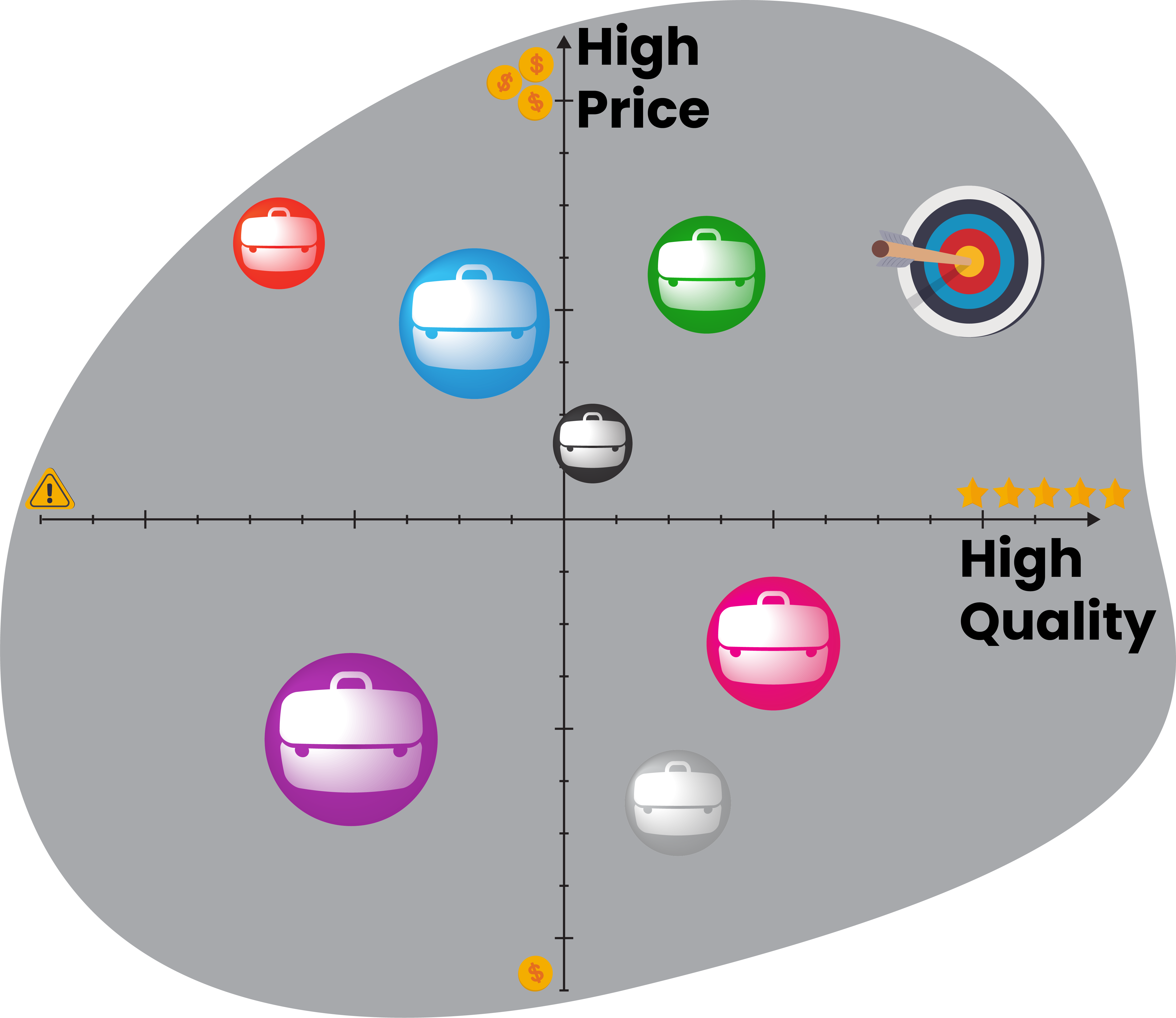
Product positioning is something inherently different from brand positioning. Marketers need to move product, so they devise marketing and messaging strategies to curry the favor of their intended audience. They’re trying to convince a customer that their product beats the competition. They’ll focus on attributes, features, and benefits relative to customers’ needs, wants, and preferences.
Let’s say your company sells gourmet chocolate bars. They’re $12 each, so this isn’t a Snickers or a Kit Kat. You might have several audience segments you’re looking to capture, and you’ll vary your positioning for each group. For people who have a more high-end palate, you might talk up ingredient sourcing, sustainable production and fair wage practices, dark chocolate potency, the fancy-pants Madagascar vanilla, exclusivity in distribution, etc. You’re homing in on the components of the product that make it distinctive from the other $12 chocolates on the block because this audience cares about a certain level of taste and how their chocolate is made. For other segments, you’d perhaps vary or tweak the story.
While product positioning is important, it’s always subservient to brand positioning. If you have a strong aversion to what a brand stands for, then you won’t likely be its product evangelist. Think about the companies people boycott for political, social, or environmental reasons. They’re not knocking the products, per se — in fact, they may have purchased and loved them at one point — but now they shy away from them because the brand doesn’t align with their belief or value system.
Brand positioning is product-agnostic. It aims to occupy a higher, conceptual place in the minds and eyes of customers. Brand position is about trying to establish a relationship based on shared or aspired values, belief systems, and business practices.
- When customers think of the brand, what words come to mind?
- How does the brand make them feel? What emotions do they associate with it?
How your customers think and feel about your brand influences which products they’ll buy. While product positioning focuses on servicing the immediate needs of customers (e.g., I need brownie mix because today was the worst, and these brownies better be chewy, chocolaty, organic, and affordable), brand positioning gets into their feelings (e.g., Duncan Hines reminds me of my childhood when my dad would bake brownies on Sunday).
Now let’s talk about why it’s important to craft positioning. First, it enforces focus. The nature of crafting brand positioning is about winnowing down to a specific offering and benefit messaging intended for a particular audience. Once you are laser focused, your marketing and messaging become powerful because you’re homing in on the needs, wants, desires, and lifestyle preferences for a select group of people. Suddenly, your brand becomes relevant and personal.
Positioning also clarifies competitive difference. Consumers are constantly posing the “why should I choose you?” question, and you need to be ready with the elements that make your brand stand out. It also influences content and creative. Once you know who you want to target and how you want to message your audience, your content and creative are a reflection of that strategic direction. No longer do you have to scratch your head wondering what would appeal to your customer — all the underlying work you did to craft your positioning gave you the intel you need.
In addition, positioning drives business decisions. From pricing and sales strategies to manufacturing and customer service, positioning gives you a clear, consistent, and cohesive path for operating your business. If you’ve defined yourself as an ultra-premium brand, you likely won’t target Dollar Stores as distribution hubs.
To return to Ries and Trout on product versus brand positioning:
Positioning: The Battle for Your Mind
Companies are focused on building products rather than brands. A product is something made in a factory. A brand is something made in the mind. To be successful today, you have to build brands, not products. And you build brands by using positioning strategies, starting with a good name.Now, we’re ready for the good stuff — how to create a brand’s positioning. There are a slew of methodologies, prisms, keys, quadrants, and fancy marketing practices that will definitely get you to a super-fine positioning place, but I like to keep it simple. My system might be different from another marketer’s process, but there’s never just one way to do something. Learn as much as you can and break the rules and formats. Make them your own.
Think like your customer 🔗
Your brand isn’t a projection of yourself onto your customers; rather, it’s a direct reflection of them. In the discovery phase, we gathered everything we could about our “target” (i.e., prospective customers). Basic demographic info simply wasn’t enough; we needed to get inside their heads and hearts. What occasions or events in their lives motivate them to purchase? What problems or challenges do they need solutions for? What are their behaviors and habits? Who influences their buying decisions? Where do they look and who do they turn to for validation?
The point was that we wanted to understand our audience so acutely that our brand, marketing, and messaging would not only be relevant, but would make a memorable mark.
A key component of the brand development process is uncovering customers’ rational and emotive cues because your brand and product benefits will directly address them. From the perspective of your customer, you want to make sure you answer these key questions before you formulate any benefit language. If your benefits don’t address what they’re feeling, thinking, and wanting, they won’t resonate. And if they don’t resonate, your customer will move on to someone else.
Take a step back and place yourself in your customer’s shoes. Every purchase they make is a risk of time and money lost. The stakes are higher for them, so adopt all the traits you’ve uncovered in your research — become them and then respond from their point of view: What does the brand do for me? How would I describe the brand? How does the brand make me look? How does it make me feel?
Create a brand identity prism 🔗
In 1994, famous marketer Jean-Noel Kapferer introduced the concept of the brand identity prism in his book Strategic Brand Management. Kapferer’s prism is a model that helps marketers develop strong brand identities through embodied human characteristics.
The prism is comprised of six facets, which consumers will often associate with your brand:
- Physique: the tactile physical characteristics or iconography of your brand. When people first hear the name of your brand, they immediately conjure a visual of the kinds of products you produce. For Target, customers think of the iconic red bull’s-eye. For Apple, people visualize sleek, slim products.
- Personality: the character (or persona) of your brand as expressed through style, color, design, tone of voice, language, and mannerisms. When consumers think of Glossier, they immediately get a warm, witty, playful vibe.
- Culture: the beliefs and value systems that imbue the whole of an organization. For example, Tesla exudes a cultural vibe of risk-taking and innovation. Patagonia embodies social awareness and responsibility.
- Relationship: the connection established between a brand and its customers and the emotional intangibles they expect beyond the products. For Trader Joe’s, customers know they’ll get cheery, accommodating service and personalized product recommendations as soon as they set foot in the store.
- Reflection: the person most likely to purchase your products, i.e., the stereotypical customer. For Nespresso machines, that’s coffee lovers in urban areas who have money to spend.
- Self-Image: how customers want to see themselves, i.e., their aspirational identity. It’s about how they want to feel, think, look, and act. For H&M, customers might view themselves as stylish, on-trend, young, fun, and unique.
Physique, relationship, and reflection are externalized, whereas personality, culture, and self-image are an invitation to turn inward.
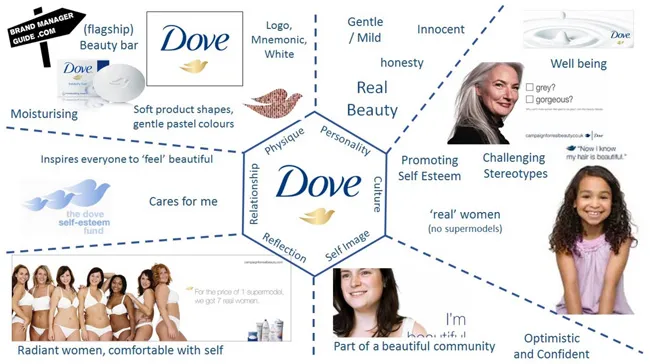
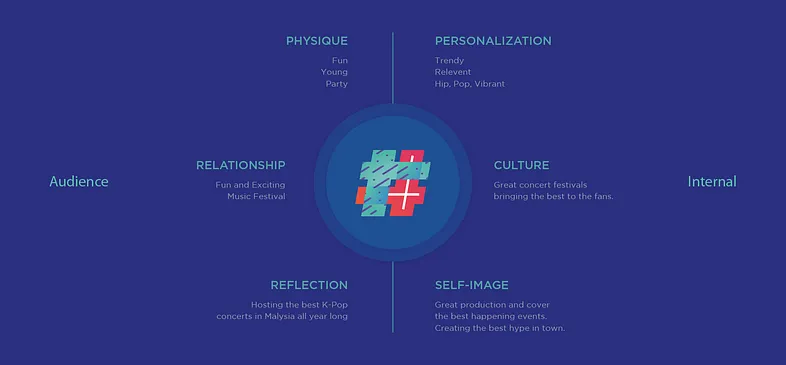
Design a brand positioning map 🔗
The brand positioning map (or perception map) is a visual representation of a brand’s strengths and weaknesses in relation to the competition, based on consumer perception. The axes represent traits important to the target audience. The map can distill tedious Excel spreadsheets into a simple, organized view of the category landscape. It creates alignment on current and future business strategies and potential market opportunities.
For example, take a look at Ann Inc.’s map below and how you can talk about your brand and formulate its positioning. Ann Taylor produces premium clothes for the working woman. Already, that sets itself apart from Gap and H&M. Now we’re in the nascent stages of framing the brand, but we’re not getting fancy just yet.
In terms of new product development or brand extensions, you can also identify the terrain Ann Taylor and Lou Grey (both Ann Inc. properties) occupy. You notice a gap in the value space, and you might ask yourself if you want to create formal attire at an affordable price. Is this a strategy worth pursuing?
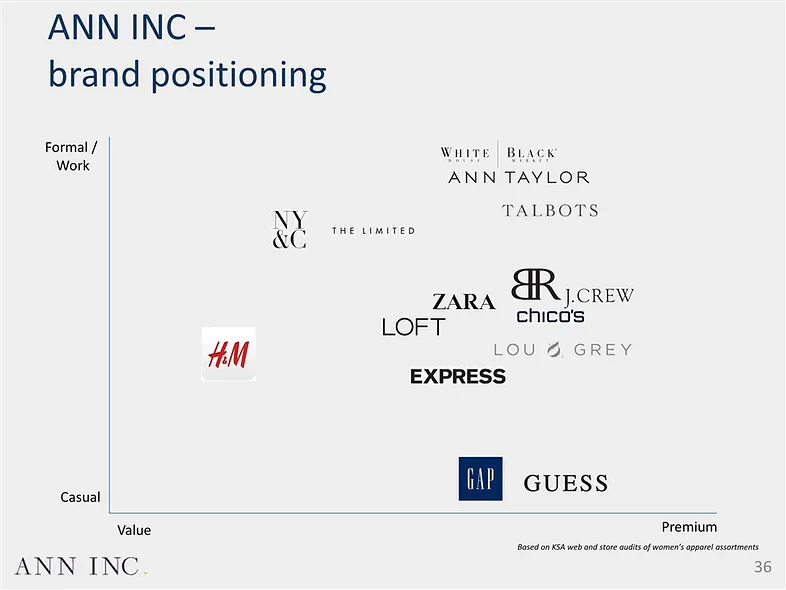
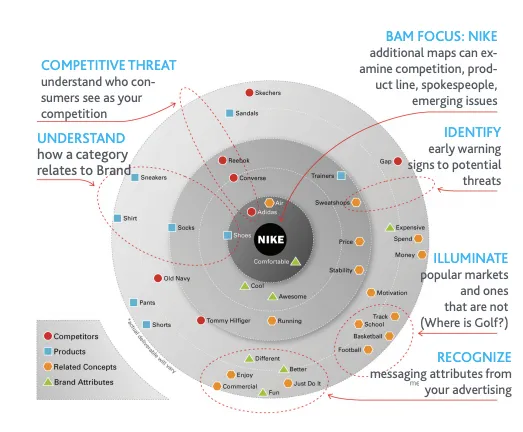
Nielsen developed a tool that searches and sifts through online conversations about brands and then maps words and phrases that consumers closely associate with a particular brand. The market research company created a brand association map for Nike. Think of brand association maps as a derivative of perceptual maps, where the proximity of words drives correlation and a consumer’s perception of how brands are different or similar from one another.
Taking the positioning map a step further 🔗
While positioning maps are a powerful tool, they don’t account for business objectives and financial results. A centrality-distinctiveness map (C-D map), designed by the authors of this landmark Harvard Business Review article, evolves the traditional perception map and layers in the money side of the equation, whether it’s a brand’s sales or pricing strategy.
The purpose of a C-D map is to strike a balance between two seemingly disparate objectives: distinctiveness (i.e., the attributes that make you stand out) and centrality (i.e., the commonalities that unify brands in a particular category). The delicate balance between the two drives everything about your brand, including positioning, messaging, marketing, and product development. It impacts how your customers perceive your brand, its adoption, and profitability. I love this concept because it refines the perception map in a way that guides us closer to effective positioning, but it also draws together brand positioning and business performance.
Remember, these maps, methodologies, quadrants, and charts exist as potential tools in your arsenal. There is never just one way to define and build a brand, and I’ve used varying tools depending on the client, category, business size, and my mood. These are simple, common tools that won’t give you agita.
The positioning bull’s-eye framework 🔗
I love the bull’s-eye framework because it forces you to start at a compact, simplistic place and slowly layer elements of complexity — all of which make for a distinctive and unique proposition. Some of my peers prefer the brand wheel approach, but you should determine what works best for you.

For the bull’s-eye, we start with the brand mantra (or brand essence), which is a single succinct sentence that encapsulates the core characteristic of the brand expressed in a simple, clear way. It’s who the brand is deep down. The mantras are internal-facing, but the external byproducts are slogans and taglines. It’s formed by marrying the brand function or benefit to a descriptive modifier (describes the benefit) and an emotional modifier (describes the result). It’s emotional, relatable, and unique.
Powerful brand mantras do the following:
- Connect and communicate directly with the consumer
- Clarify what the brand means to the consumer in a clear, simple way
- Invigorate the consumer and embolden them to act
Examples:
- Disney’s mantra: Fun [emotional modifier] family [descriptive modifier] entertainment [function]
- Nike’s mantra: Authentic [emotional modifier] athletic [descriptive modifier] performance [function]
- BMW’s mantra: [emotional modifier] Ultimate [descriptive modifier] driving machine [function]
Remember that perception map? It’s useful in the next layer: points of parity (POP) and points of difference (POD). But here’s where you take the visual map and get specific and verbal. The POPs are the similarities your brand shares with competitors; your claims and benefits mostly align with theirs. On the flip side, PODs will shine a spotlight on how you stand out — your competitive advantages. You could probably make the case for a million ways you’re different, but zero in on the qualities that matter most to your customers, those that are truly distinctive, innovative, or unique, and can be proven.
Jill Avery’s and Sunil Gupta’s Core Curriculum reading on brand positioning reiterates this:
Jill Avery’s and Sunil Gupta
Strong value claims should resonate with consumers, providing them with a narrative that feels personally meaningful. Claims can be made at three levels: feature-or attribute-based claims that focus on a special feature, ingredient, or capability of the product or service (“What’s in it?”); benefit-based claims that focus on the specific benefits customers receive from using the product or service (“What’s in it for me?”); and value-based claims that focus on helping consumers achieve the values they hold to be important (“Why is it important to me?”)… Laddering up from feature-based to benefit-based to value-based claims can increase brand resonance.Factors to consider in your POD strategy could include price (value positioning), an underserved market segment or niche (market positioning), quality of service, distribution, product or service performance (benefit positioning), a unique ingredient, process or methodology (feature positioning), and more.
For example, consider meal kit services, such as Hello Fresh, Plated, Sun Basket, Purple Carrot, and Home Chef. In terms of POPs, they’re all meal kit providers that sell convenient, meal-ready food kits. However, if I’m Purple Carrot, my POD is that I’m a vegan-only provider. If I’m Sun Basket, I offer organic, paleo, and gluten-free meals. If a customer is vegan, they’re more apt to select Purple Carrot because it aligns with their lifestyle.
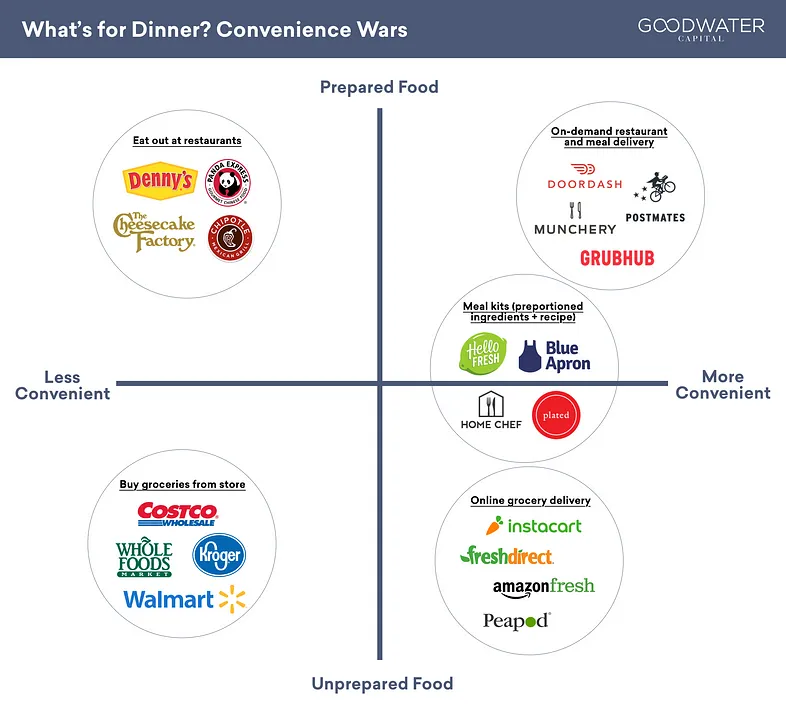
For another example take online dating sites and apps. There’s Bumble, Match, Christian Mingle, Jdate, Tinder, Grindr — the list goes on and on. All of the platforms offer dating or mating services, but their distinction lies in niche audiences and levels of relationship commitment.
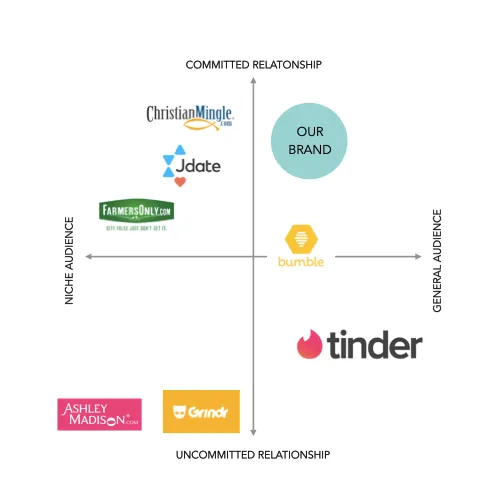
In short, POP defines where brands converge and POD defines where they diverge.
Now that you’ve distinguished why customers should choose your brand, you’ve got to prove your promise. Substantiators come together as your reason to believe. They’re the evidence that supports your claims. A few examples of potent proof points include the following:
- Backed by science: Trials and studies support your claims. It goes without saying that the more unbiased and independent the research is, the better.
- Reviews and testimonials: Nothing is more powerful than other people, who laid down their hard-earned cash for your product, validating the efficacy of your brand. Video testimonials propelled Proactiv skin care products to market dominance. Reviews from people who don’t have a vested stake in a company get more credence than a brand touting its own awesomeness.
- Category longevity or expertise: Whether you’re the market leader or you’ve been in business for 100 years, sustainability, viability, and expertise can be proof points in and of themselves.
- Awards, accreditations, seals of trust/excellence: People love awards and seals, and if your brand has been recognized by peers and trusted companies, it further substantiates your story.
Values, personality, and character are where the party begins. This is the moment when you anthropomorphize the brand and bring your Frankenstein to life in the form of human characteristics. Remember when we talked about the difference between brand and product positioning? A brand has to establish a visceral, emotional connection with its customers.
People are hardwired for empathic connection and bonding over commonalities. Our initial impulse is always emotional and reactive (think fight-or-flight response), and pragmatic and rational thinking come in when the dust clears. A successful brand has to achieve both, and you do this by breathing life into your brand in the form of personality, values, and character.
Once you have your brand fundamentals in play, now you can conceive of its visual identity (or brand system, brand standards, etc.). Think of your brand fundamentals as the bones of your house while the visual identity brings your house into Technicolor. Your visual identity is the art you hang on the walls, the color of the curtains you hang, and the wallpaper pattern you choose. It’s the furniture that outfits the room and the fragrant candles you burn.
In a nonmetaphorical sense, you’re composing the visible elements of your brand, such as color palette, logos, fonts, photography, illustrations, design architecture and format, and more.
Visual identity examples: British Council, Volkswagen, Ben & Jerry’s, and Lexus. I’m also a big fan of Google Design’s page.
Corral the cats: Craft the positioning statement 🔗
While your position in the market is driven by customer perception, your statement is your desire or intention for a specific perception. In the end, prospective customers have the power to validate or dismiss your offering.
To (target): Start by addressing the audience you’re serving directly. Specificity is key. For example, you wouldn’t refer to all millennials in your positioning, but might be focused on African-American millennial women.
Your brand is the (category): In which industry do you operate? Your category or market gives you a point of reference that helps define the space in the marketplace where you compete.
That is the (benefit): Define the promise you’re making to your audience. What are the main benefits you’re delivering?
That’s because (evidence): Why should your customers believe you? What supporting points, evidence, and claims can you use to back up the benefits?
All positioning needs support points. They take your customers on a journey and ensure that all their problems are solved and that they have shiny, happy feelings post engagement and purchase.

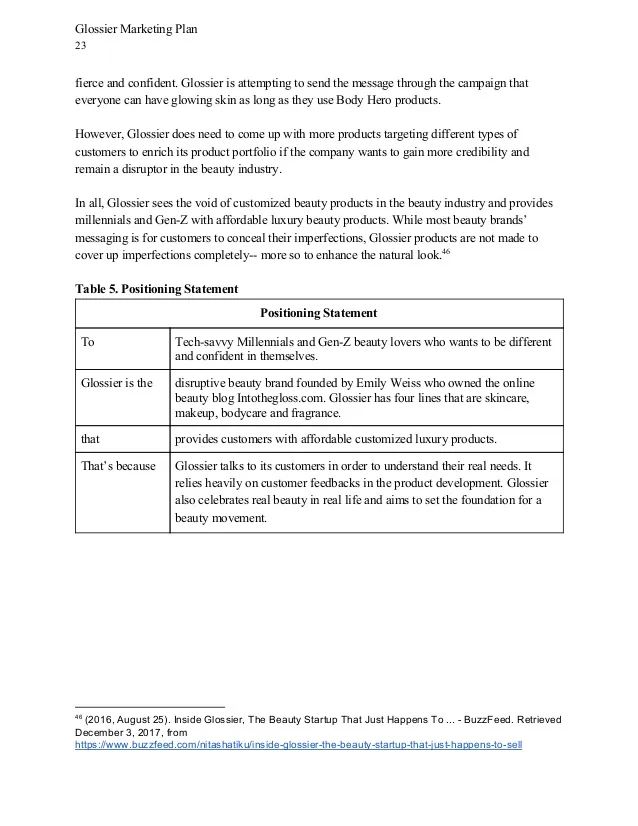
Brand purpose is a company’s reason for being, not selling. It’s human and puts the consumer at the center of the brand. The most successful brands incorporate their positioning into their purpose: What do I believe? What are my values? What are my vision and mission? Why did I start this business? What keeps me going? What sustains it?
Ultimately, brand purpose is your brand’s philosophical heartbeat. It’s not an ad campaign, a slogan, or a marketing tactic. A brand’s purpose only means something if every aspect of the brand and business supports and upholds the purpose. For example, Patagonia donated its $10-million tax break to environmental causes. Target also does an excellent job of articulating its brand purpose.
Additional resources 🔗
- “How to be Absolutely Sure You’ve Got an Effective Brand Positioning Strategy”
- MIT OpenCourseWare offers many free online courses in business, entrepreneurship, marketing, and management. Check out this lecture on positioning (PDF) and this detailed tutorial on positioning (PDF) with real brand examples.
- The classic marketing tome mentioned earlier is Positioning: The Battle for Your Mind by Al Ries and Jack Trout.
- “Don’t Confuse Mission With Brand Positioning”
- This excellent primer covers creating positioning statements.
- Hubspot’s “The 2018 Guide to Successful Brand Positioning in Your Market”
- WARC is an incredible repository for studies, articles, research, and educational materials.
- Harvard Business Review’s “The Most Successful Brands Focus on Users — Not Buyers”
- Harvard’s Core Curriculum reading on brand positioning ($15.90): This paper from 2014 is solid and used in core business school curriculums across the country. I’ve purchased a few supplemental materials from HBS as well, and I’ve been satisfied with the depth and quality every time.
Positioning is about perception — how your customers think and feel about your brand compared to other options. Crafting a statement relies on in-depth research and analysis of your customer, competition, and company. If you’re looking to jumpstart the discovery process, check out my second article in this series.
Next up? Benefits and reason to believe.


